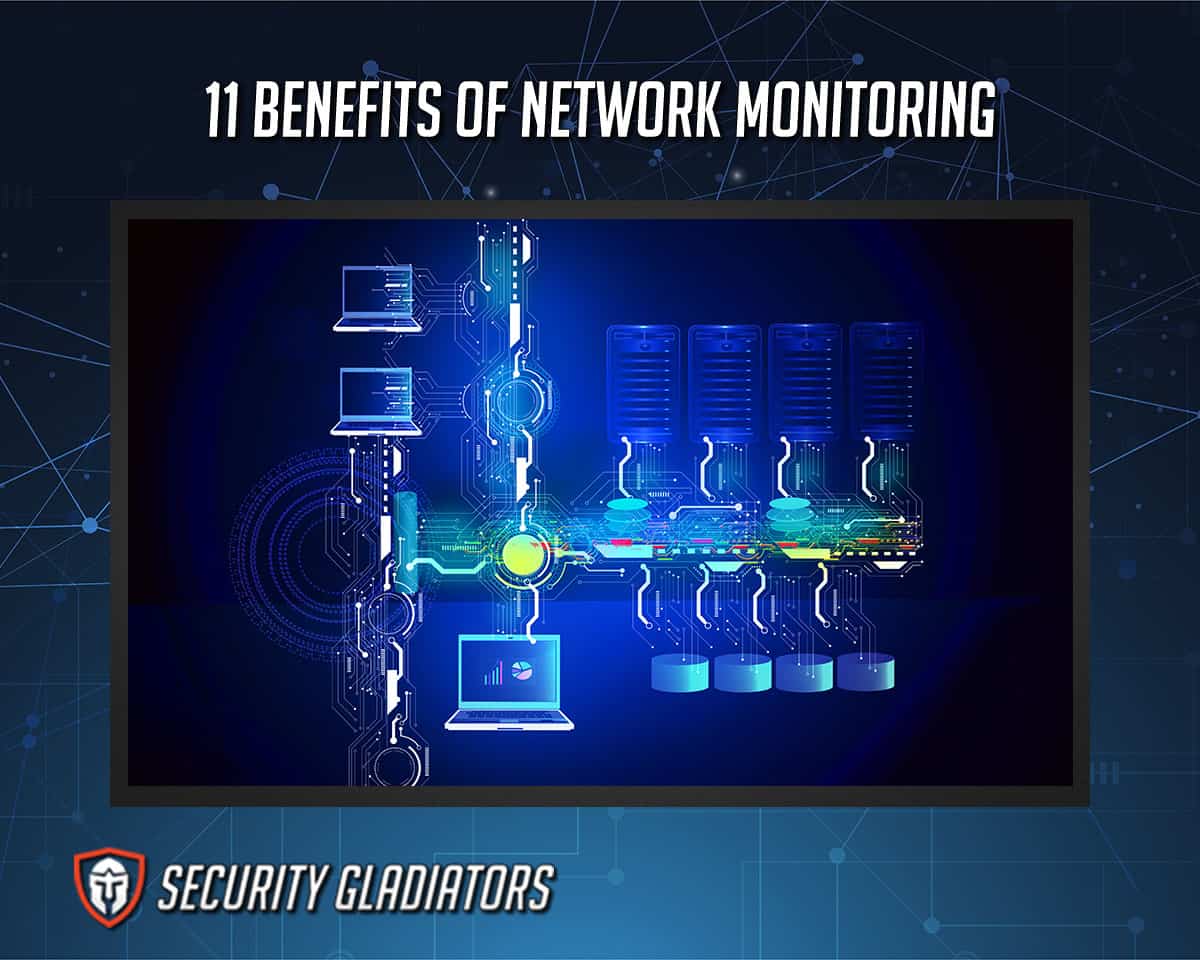One of the most dreaded types of IT breakdowns involves the network. Following an interruption, a company will have financial and operational losses. The longer a problem persists, the more staff time it consumes, productivity, and end-user happiness. IT professionals need more visibility and capabilities to prevent network breakdowns rather than react.

IT departments have restricted access to a user’s device or endpoints in the current remote working environment. Remote users can utilize network performance monitoring systems to view, monitor, optimize, troubleshoot, and report network availability.
Some of the benefits of networking monitoring include:
- Network Visibility
- Keeping Compliance
- Avoiding Downtime
- Rapidly identifying and resolving problems
- Identifying Security Risks
- Monitoring Bandwidth Usage
- Planning for Capacity
- Introducing New Technologies
- Making IT Teams Available
- Return on Investment
- Selecting the Best Network Monitoring Solution
Table of Contents
1. Network Visibility
Without complete network visibility, it is impossible to comprehend the network’s performance. Therefore, the organization must be able to monitor all network traffic, as well as each connected device and common performance indicators. Good network monitoring tools give extensive monitoring capabilities that cover the entirety of your network. Thus, there won’t be any hidden performance-affecting issues on the network.
2. Keeping Compliance
Compliance can be maintained with network monitoring solutions, which provide enterprises with crucial network analysis tools. Companies can stay on track with real-time topology maps, continuous monitoring, and post-association for VLANs and secure channels. This all helps keep the company compliant with their requirements.
3. Avoiding Downtime
Even with the most advanced network monitoring tool, companies can’t ensure 100% uptime, but monitoring tools can prevent outages. Network monitoring systems watch for traffic that indicates a device or network breakdown. So, the company can prevent unplanned downtime and maximize service uptime.
4. Rapidly identifying and resolving problems
Performance concerns might arise even when no one is at the workplace. The company must be aware of a problem that occurs outside of business hours. Network monitoring solutions continuously monitor a network, allowing them to detect such difficulties. A good network monitoring solution won’t send out notifications for these issues immediately since they may be lost when the staff returns. Instead, the solution should delay the alert until a network administrator-determined time.
5. Identifying Security Risks
The prevention of cybercrime presents many difficulties for organizations. Cyberattacks are becoming complex and challenging to track. That’s why it’s crucial to have a system for monitoring network performance. Network monitoring works to secure systems and data from intrusions. As a result, the network is safe, and all workloads can continue to meet the required level of security.
6. Monitoring Bandwidth Usage
Most network managers examine bandwidth use as a critical performance parameter. Every organization should utilize as much bandwidth as feasible while providing efficient service. A network monitoring solution tracks bandwidth usage, alerts administrators when it reaches critical levels, and ensures QoS (quality-of-service) protocols are working appropriately.
7. Planning for Capacity
As your enterprise expands, so will the network. Any additional IT resources your business requires to run smoothly will be added, including new hardware, end users, software, servers, and virtual environments. Without a grasp of how the network operates, there won’t be a viable way to scale the business. An ineffective network for the firm will ruin the company in time.
8. Introducing New Technologies
Businesses need new technologies and services. Managing the network environment is crucial for these projects. Thus, network performance monitoring helps scale technology to meet corporate needs. Network monitoring is an excellent tool for learning how equipment and technology are holding up over time.
9. Making IT Teams Available
Network monitoring frees the IT department, allowing IT staff to focus on other tasks.
10. Return on Investment
Investing in network monitoring pays off quickly. The organization will save money by not hiring more people to monitor the network. Network monitoring prevents income loss from outages and downtime.
11. Selecting the Best Network Monitoring Solution
Network monitoring allows organizations to identify problem areas in the company’s network. As a result, businesses can easily pick out the best network monitoring solution that meets all needs.
What is Network Monitoring?
Network Monitoring is routinely checking for traffic delays and component failure issues. Network monitoring systems continuously scan the network and alert administrators by text message, email, or Slack if a problem arises. Network monitoring software also concentrates on internal network problems like overloaded routers, down servers, or network connection problems that may impact other devices.
Note:
Network monitoring systems can also initiate failover to remove malfunctioning devices or circuits off duty until repaired. A preemptive network monitoring tool should prevent delays or breakdowns by spotting anomalies that could cause outages.What is the Primary Goal of Network Monitoring?
Network monitoring is a fundamental requirement for any company. The main objective is to keep track of how well the computer network is being utilized and its performance and to locate any systems that are running slowly or improperly. The system will then sound an alarm and send an email to the network administrator if there are any service disruptions. This method will significantly decrease costs and resolve multiple issues. It is the most effective method for ensuring that the organization works well.
What are the Best Practices for Network Monitoring?
The best practices for network monitoring include:

- Mapping the Network Architecture: Without a comprehensive perspective of the network architecture, it is impossible to monitor it effectively. Network monitoring tools can provide reports automatically in minutes, saving users the hassle of manually collecting this information. Furthermore, users can guarantee that every piece of equipment is optimally positioned and configured after creating a current network map.
- Using Network Monitoring Tools: Network analysis software helps maximize the network’s performance by revealing where the most bandwidth and resources are consumed. Network monitoring systems also optimize comprehensiveness by keeping tabs on everything from CPUs and storage to VoIP and wireless networks. As a result, they have a comprehensive picture of the infrastructure.
- Carrying out System Analysis: Monitoring can analyze how the system is performing. However, the system must be appropriately sized before implementing monitoring to see if its resources are sufficient for the company’s needs.
What are the Limitations of Network Monitoring?
The two significant limitations of network monitoring are security and connectivity. Any solution that uses public connectivity must be secure; employing a cloud network monitoring solution requires a lot of faith in the cloud provider. With internally deployed network monitoring tools, the systems are often located in the network’s most central location. Connecting to an external entity with a cloud-based system isn’t as simple, and losing access to regulated elements is a genuine danger. However, this won’t be a problem if the service provider has implemented an automatic backup mechanism.
What are the Types of Network Monitoring Tools?
There are many different tools available on the market but we generally split them into 3 different types of network monitoring tools, they are listed below.
| Type | Definition | Difference |
|---|---|---|
| SNMP Tools | SNMP is the standard protocol used to interact with network hardware. SNMP polls real-time network status and shows how resources like memory consumption, process utilization, and data transfer are being used. | Active tools can be used to check if a user has quality performance or connectivity issues, whereas SNMP can’t. |
| Flow-based Tools | Flow-based tools record and evaluate traffic flow (i.e., actual user data) to gather aggregate information about the protocols and users utilizing a link’s capacity (top talkers) or investigate a specific sequence of packets to identify performance difficulties between a client and a server. | Flow-based solutions collect only performance data from traffic statistics; in contrast, SNMP may acquire a wide range of other performance data, including interface failures and CPU use. |
| Active tools | Active monitoring tools employ an expanded version of ping and traceroute. These instruments inject data frames and packets and send them to neighboring devices. The destination arrival time, jitter, and delay are recorded. Active network monitoring tools are perfect for identifying network congestion. Active tools also help to differentiate between active and inactive links. | Active monitoring enables the provider to proactively address possible customer service concerns, minimizing or eliminating client downtime. Flow-based monitoring helps get to the bottom of problems and how customers act, giving more insight into the customer experience. |

